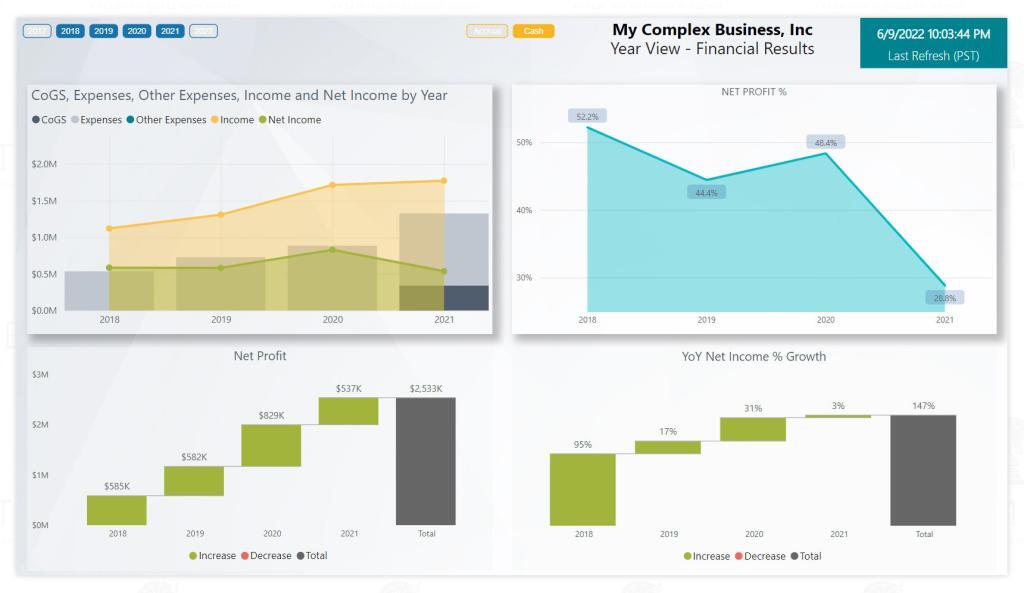
As a business owner, mastering your skills by learning how to analyze your business financial statements is crucial for making informed decisions and ensuring the long-term success of your business.
This article follows on from our previous articles on:
- Understanding your P&L and Cashflow Statements
- How to Read and Interpret your Balance Sheet
- Demystifying the Chart of Accounts
- Mastering Cashflow Management in Uncertain Times
With the help of QuickBooks Online, a powerful accounting software, you can simplify your bookkeeping tasks and gain access to accurate and up-to-date financial statements. In this comprehensive guide, we will walk you through the process of reviewing your monthly financial statements in QuickBooks Online. By following this step-by-step approach and learning how to calculate key metrics and ratios, you will be equipped with the knowledge and tools to assess your business’s financial health and take strategic actions for growth.
Understanding Your Financial Statements
Before diving into the details, let’s familiarize ourselves with the three primary financial statements:
- the income statement (also known as the Profit and Loss Statement),
- the balance sheet, and
- the cash flow statement.
Learning how to analyze your business financials through these key statements provides valuable insights into different aspects of your business’s financial performance.
The Income Statement (P&L)
The first key in learning how to analyze your business financial statements is the Income Statement, also known as the profit and loss statement. This summarizes your business’s revenues, expenses, and net income or loss for a specific period. It allows you to assess profitability, track revenue trends, and identify areas for cost-saving opportunities.
The Balance Sheet
The Balance Sheet provides a snapshot of your business’s financial position at a given point in time. It presents the assets, liabilities, and equity, giving you an overview of your business’s financial stability and liquidity.
The Cashflow Statement
The Cash Flow Statement tracks the flow of cash into and out of your business over a specific period. It categorizes cash flows into operating, investing, and financing activities, providing insights into your business’s cash management and ability to meet financial obligations.
Analyzing the Income Statement
The income statement offers valuable information regarding your business’s revenue, expenses, and overall profitability. Here are some key aspects to consider during your analysis:
- Revenue Trends:
Monitor revenue trends to identify patterns and fluctuations in your business’s sales. Calculate revenue growth by comparing current revenue with previous periods, enabling you to assess the effectiveness of your sales strategies.
- Gross Profit Margin:
Evaluate the gross profit margin, which indicates the profitability of your products or services. Calculate it by dividing the gross profit (revenue minus cost of goods sold) by revenue. A higher gross profit margin suggests better cost efficiency and profitability.
- Operating Expenses:
Review your operating expenses, including rent, utilities, salaries, marketing, and administrative costs. Identify any significant changes and assess whether they align with your business’s goals and industry benchmarks.
- Net Income or Loss:
Assess your business’s net income or loss to understand its overall profitability. Compare it with previous periods to identify trends and evaluate the success of your business strategies.
Analyzing the Balance Sheet:
The balance sheet provides a snapshot of your business’s financial position, allowing you to assess its assets, liabilities, and equity. Here’s what you should focus on during your analysis:
- Assets:
Evaluate changes in your business’s assets, such as cash, accounts receivable, inventory, and fixed assets. Ensure that your assets are properly managed and utilized to support your business operations effectively.
- Liabilities:
Review your liabilities, including accounts payable, loans, and credit card balances. Understand your payment obligations and consider optimizing your debt structure to minimize interest expenses.
- Equity:
Assess your business’s equity, which represents the net worth of the business. Monitor changes in equity to gauge the accumulation of retained earnings or the impact of owner’s investments or withdrawals.
Assessing the Cash Flow Statement:
The cash flow statement provides insights into the inflow and outflow of cash in your business. Consider the following aspects during your analysis:
- Operating Cash Flow:
Evaluate your operating cash flow to determine if your business generates sufficient cash from its core operations. A positive operating cash flow indicates healthy operations, while a negative cash flow may require attention to improve profitability or cash management.
- Investing and Financing Activities:
Examine the investing and financing sections of your cash flow statement. Look for significant cash flows related to investments in assets, acquisitions, or divestitures. Assess financing activities, such as loans and equity investments, to understand their impact on your business’s cash position.
Calculating Key Metrics and Ratios - short cuts to analyzing your financials:
Key metrics and ratios provide valuable insights and shortcuts into your business’s financial performance and help you benchmark against industry standards.
furthermore, tracking these metrics over time tells you in what direction your business is heading. Here are a few important metrics and how to calculate them:
- Current Ratio:
Calculate the current ratio by dividing current assets by current liabilities. This ratio indicates your business’s ability to meet short-term obligations and maintain liquidity.
- Debt-to-Equity Ratio:
The debt-to-equity ratio assesses your business’s financial leverage. Calculate it by dividing total debt by total equity. This ratio helps you understand your business’s dependency on debt financing and its financial risk.
- Gross Profit Margin:
Calculate the gross profit margin by dividing gross profit (revenue minus cost of goods sold) by revenue. This ratio indicates your business’s profitability and cost efficiency.
- Return on Investment (ROI):
Calculate ROI by dividing the net profit from an investment by the cost of the investment, then multiply by 100 to express it as a percentage. ROI helps evaluate the effectiveness of investment decisions.
Taking Action
Learning how to analyze your business financial statements is only useful if it informs you to take action. We call this “adding insight to your instincts”.
Based on your financial analysis, you can take several actions to optimize your business’s financial health and drive growth. Here are some key steps to consider:
- Improve Working Capital Management:
Optimize your accounts receivable and accounts payable processes to enhance cash flow. Implement effective billing and collection strategies, negotiate favorable payment terms with suppliers, and maintain a healthy cash reserve.
- Adjust Pricing Strategies:
Analyze revenue and gross profit margin trends to assess the effectiveness of your pricing strategies. Consider adjusting prices based on market conditions, cost fluctuations, and profitability targets.
- Review Expense Management:
Regularly review and evaluate your operating expenses to identify areas where cost-saving measures can be implemented. Seek opportunities to streamline operations, negotiate better terms with vendors, and control unnecessary expenditures.
Seeking Professional Assistance
Understanding what these metrics are and how to use them is one thing. However, many of us need help to save us time and effort and to “cut to the chase”.
Estmere offers expert guidance across all aspects of Bookkeeping, Payroll Management, Financial Analysis, and Strategic Financial Management. This provides personalized advice and insights tailored to your business’s unique needs.
Furthermore, Estmere can analyze your business financial statements on an ongoing/real time basis and present this in easy-to-understand graphical formats to get you to the crux of what you need to know more quickly. This is part of our Financial Analysis services.

Conclusion
By diligently reviewing and analyzing your monthly financial statements in QuickBooks Online, you gain a comprehensive understanding of your business’s financial health and performance.
Through a thorough analysis of the income statement, balance sheet, cash flow statement, and key metrics and ratios, you can identify areas for improvement, make informed decisions, and take strategic actions to drive your business’s success.
Remember, financial analysis is an ongoing process, and regular monitoring of your financial statements will empower you to make timely adjustments and optimize your business’s financial outcomes.
With QuickBooks Online as your ally, and a seasoned professional such as Estmere, you have the tools and knowledge to navigate the financial landscape with confidence and achieve your business goals.














































